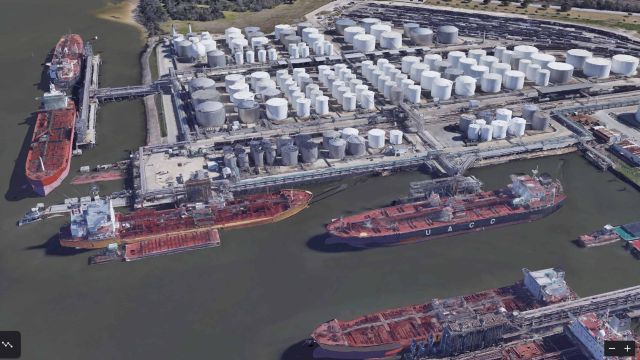
Tankers docked at the Houston Ship Channel. (Source: Google Earth)
Paradoxically, the tanker segment of the global oil and gas industry is booming as most of the sector struggles, and that boom will likely continue as long as crude production continues to surge.
The boom’s metric is the average day rate for a Very Large Crude Carrier (VLCC). In an April 1 report, GlobalData analyst Ravindra Puranik said day rates soared from an average of $22,500 on Feb. 3 to $175,000 on March 12. It’s because onshore storage is limited and rapidly filling up.
“Tankers function as a safety valve and floating storage could reach unprecedented levels,” Erik Broekhuizen, global manager of tanker research and consulting for Poten & Partners Inc., said during an April 2 webinar. “Over the next one to two months, we expect to see continued rate volatility as oil supply and demand try to find an equilibrium in a highly uncertain market. Initially, all demand will continue its free fall while supply is still ramping up.”
The U.S. Energy Information Administration (EIA) reported that U.S. onshore crude oil inventories increased in the week ending March 27 by 13.8 MMbbl to 469.2 MMbbl—the largest weekly build since the last downcycle in 2016. Those figures exclude the Strategic Petroleum Reserve, which has about 65 MMbbl of spare capacity. By comparison, about 75% of the world’s storage capacity is already utilized.
“At the current rate, land-based stocks will fill up in about four weeks,” Broekhuizen said. “That leaves floating storage.”
Reports have circulated that the Saudis and Russians were on the verge of an agreement to end their market share war. However, the likelihood that the two producers would reduce output was treated with skepticism by oil analysts.
Saudi Arabia moved quickly to secure floating storage after the collapse of OPEC+ on March 6. Bahri, the Saudi national shipping carrier, chartered 18 VLCCs in a 10-hour span. For a company that rarely secures third-party vessels on the spot market, it was an impressive effort, Broekhuizen said.
A typical week sees about 50 VLCC contracts. As more charterers entered the market, that number jumped to 84 during the week of March 9. During the week of March 23, the total was 74.
Floating storage is not limited to oil. Production has not yet throttled back in meaningful terms so large volumes of crude continue to make their way downstream. Refiners must seek storage for their products, as well, mainly transportation fuels with significantly reduced demand as many countries impose lockdowns and travel bans due to the COVID-19 pandemic. One newbuild VLCC was reported to have been filled with jet fuel.
In theory, the global tanker fleet can store as much as 3 billion bbl, Broekhuizen said. A more realistic estimate is 300–500 MMbbl, he said, because the bulk of tanker capacity is already in service making regular deliveries.
“The contango in the oil market is so steep that even at tanker rates at or above $100,000/d, floating storage makes sense,” Broekhuizen said. On April 3, the May near-month price for WTI closed at $28.72 and the May 2021 price closed at $35.45. “As long as the economics work, traders will charter more tankers for floating storage.”
Recommended Reading
Air Products Sees $15B Hydrogen, Energy Transition Project Backlog
2024-02-07 - Pennsylvania-headquartered Air Products has eight hydrogen projects underway and is targeting an IRR of more than 10%.
Humble Midstream II, Quantum Capital Form Partnership for Infrastructure Projects
2024-01-30 - Humble Midstream II Partners and Quantum Capital Group’s partnership will promote a focus on energy transition infrastructure.
SunPower Begins Search for New CEO
2024-02-27 - Former CEO Peter Faricy departed SunPower Corp. on Feb. 26, according to the company.
Green Swan Seeks US Financing for Global Decarbonization Projects
2024-02-21 - Green Swan, an investment platform seeking to provide capital to countries signed on to the Paris Agreement, is courting U.S. investors to fund decarbonization projects in countries including Iran and Venezuela, its executives told Hart Energy.
TechnipFMC Eyes $30B in Subsea Orders by 2025
2024-02-23 - TechnipFMC is capitalizing on an industry shift in spending to offshore projects from land projects.






